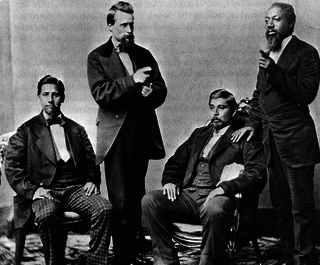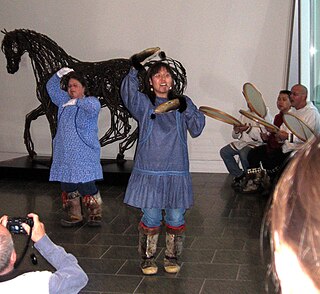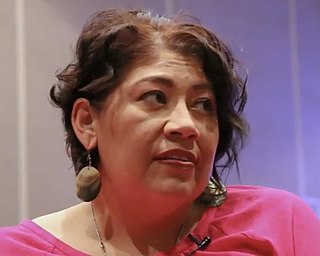Related Research Articles

Blood quantum laws or Indian blood laws are laws in the United States that define Native American status by fractions of Native American ancestry. These laws were enacted by the federal government and state governments as a way to establish legally defined racial population groups. By contrast, many tribes do not include blood quantum as part of their own enrollment criteria. Blood quantum were first imposed by white settlers in the 18th century. Blood Quantum (BQ) is a very controversial topic.

The United States has a racially and ethnically diverse population. At the federal level, race and ethnicity have been categorized separately. The most recent United States census recognized five racial categories, as well as people who belong to two or more of the racial categories. The United States also recognizes the broader notion of ethnicity. The 2000 census and 2010 American Community Survey inquired about the "ancestry" of residents, while the 2020 census allowed people to enter their "origins". The Census Bureau also classified respondents as either Hispanic or Latino, identifying as an ethnicity, which comprises the minority group in the nation.

Ward LeRoy Churchill is an American activist and author. He was a professor of ethnic studies at the University of Colorado Boulder from 1990 until 2007. Much of Churchill's work focuses on the historical treatment of political dissenters and Native Americans by the United States government, and he expresses controversial views in a direct, often confrontational style. While Churchill has claimed Native American ancestry, genealogical research has failed to unearth such ancestry and he is not a member of a tribe.

Jamake Highwater was an American writer and journalist of Eastern European Jewish ancestry who mispresented himself as Cherokee.
Racial passing occurs when a person who is classified as a member of a racial group is accepted or perceived ("passes") as a member of another racial group. Historically, the term has been used primarily in the United States to describe a black or brown person or of multiracial ancestry who assimilated into the white majority to escape the legal and social conventions of racial segregation and discrimination. In the Antebellum South, passing as white was a temporary disguise used as a means of escaping slavery. Other instances include cases of Jews in Nazi Germany attempting to pass as "Aryan" and non-Jewish to escape persecution.
Cherokee heritage groups are associations, societies and other organizations located primarily in the United States. Such groups consist of persons who do not qualify for enrollment in any of the three federally recognized Cherokee tribes. As the Cherokee Nation enrolls all people who can prove descent from a Cherokee ancestor, many of these groups consist of those who claim Cherokee ancestry but have no documentation to prove this alleged heritage. Some have had their claims of ancestry checked and proven to be false. A total of 819,105 Americans claimed Cherokee heritage in the 2010 Census, more than any other named tribe in the Census.

Native American identity in the United States is a community identity, determined by the tribal nation the individual or group belongs to. While it is common for non-Natives to consider it a racial or ethnic identity, for Native Americans in the United States it is considered to be a political identity, based on citizenship and immediate family relationships. As culture can vary widely between the 574 extant federally recognized tribes in the United States, the idea of a single unified "Native American" racial identity is a European construct that does not have an equivalent in tribal thought.

Andrea Lee Smith is an American academic, feminist, and activist. Smith's work has primarily focused on issues of violence against women of color and their communities, specifically Native American women. Formerly an assistant professor of American Culture and Women's Studies at the University of Michigan in Ann Arbor, Michigan, she is also a co-founder of INCITE! Women of Color Against Violence, the Boarding School Healing Project, and the Chicago chapter of Women of All Red Nations.
Multiracial Americans or mixed-race Americans are Americans who have mixed ancestry of two or more races. The term may also include Americans of mixed-race ancestry who self-identify with just one group culturally and socially. In the 2020 United States census, 33.8 million individuals or 10.2% of the population, self-identified as multiracial. There is evidence that an accounting by genetic ancestry would produce a higher number.
Jacqueline Keeler is a Native American writer and activist, enrolled in the Navajo Nation and of Yankton Dakota descent, who co-founded Eradicating Offensive Native Mascotry (EONM), which seeks to end the use of Native American racial groups as mascots.
The Indian princess is usually a stereotypical and inaccurate representation of a Native American or other Indigenous woman of the Americas. The term "princess" was often mistakenly applied to the daughters of tribal chiefs or other community leaders by early American colonists who mistakenly believed that Indigenous people shared the European system of royalty. This inaccurate portrayal has continued in popular animation, with characters that conform to European standards of beauty, with the most famous misrepresentation being that of Pocahontas. Frequently, the "Indian Princess" stereotype is paired with the "Pocahontas theme" in which the princess "offers herself to a captive Christian knight, a prisoner of her father, and after rescuing him, she is converted to Christianity and lives with him in his native land." - a false narrative which misrepresents the events of Matoaka's life. The phrase "Indian princess", when used in this way, is often considered to be a derogatory term, a type of racial slur, and is deemed offensive by Native Americans.

Nkechi Amare Diallo is an American white woman, college instructor and activist known for presenting herself as a black woman despite being born to white parents. She is also a former National Association for the Advancement of Colored People (NAACP) chapter president.

Redface is the wearing of makeup to darken or redden skin tone, or feathers, warpaint, etc. by non-Natives to impersonate a Native American or Indigenous Canadian person, or to in some other way perpetuate stereotypes of Indigenous peoples of Canada and the United States. It is analogous to the wearing of Blackface. In the early twentieth century, it was often white performers, who wore blackface or redface when portraying Plains Indians in Hollywood Westerns. In the early days of television sitcoms, "non-Native sitcom characters donned headdresses, carried tomahawks, spoke broken English, played Squanto at Thanksgiving gatherings, received 'Indian' names, danced wildly, and exhibited other examples of representations of redface".
Circe Sturm is a professor in the Department of Anthropology, University of Texas, Austin. She is also an actress, appearing mainly in films and commercials.

Kim TallBear is a Sisseton Wahpeton Oyate professor at the University of Alberta, specializing in racial politics in science. Holding the first ever Canada Research Chair in Indigenous Peoples, Technoscience and Environment, TallBear has published on DNA testing, race science and Indigenous identities, as well as on polyamory as a decolonization practice.
A transracial person is one who identifies as a different race than the one associated with their biological ancestry. They may adjust their appearance to make themselves look more like that race, and may participate in activities associated with that race. Use of the word transracial to describe this is new and has been criticized, because the word was historically used to describe a person raised by adoptive parents of a different ethnic or racial background, such as a Black child adopted and raised by a White couple.
Cherokee descent, "being of Cherokee descent", or "being a Cherokee descendant" are all terms for individuals with some degree of documented Cherokee ancestry but do not meet the criteria for tribal citizenship. The terms are also used by non-Native individuals who self-identify as Cherokee despite lacking documentation or community recognition.
Pretendian is a pejorative colloquialism used to call out a person who has falsely claimed Indigenous identity by professing to be a citizen of a Native American or Indigenous Canadian tribal nation, or to be descended from Native American or Indigenous Canadian ancestors. As a practice, being a pretendian is considered an extreme form of cultural appropriation, especially if that individual then asserts that they can represent, and speak for, communities from which they do not originate. It is sometimes also referred to as a form of fraud, ethnic fraud or race shifting.
The Tribal Alliance Against Frauds (TAAF) is an American non-profit organization dedicated to exposing individuals and organizations that have falsely claimed to be American Indian, as well as to educating the public on the harms to American Indian sovereignty caused by identity fraud. The organization employs certified experts in American Indian genealogy to conduct genealogical investigations of individuals who have profited from fraudulent claims of American Indian heritage.
References
- ↑ Yang, Tseming (2006). "Choice and Fraud in Racial Identification: The Dilemma of Policing Race in Affirmative Action, the Census, and a Color-Blind Society". Mich. J. Race & L. 11: 367.
- ↑ Brazil, Cleuci de Oliveira in Pelotas (8 June 2017). "'Race fraud': how a college quota scandal exposed Brazil's historic racial tensions". The Guardian. Retrieved 19 September 2020.
- ↑ Weisskopf, Thomas E. (2004). Affirmative Action in the United States and India: A Comparative Perspective. Routledge. ISBN 978-1-135-99731-1.
- 1 2 Higginbotham, F. Michael (2010). Race Law: Cases, Commentary, and Questions. Carolina Academic Press. pp. 90–100. ISBN 978-1-59460-599-4.
- ↑ Nishi, Naomi W.; Matias, Cheryl E.; Montoya, Roberto (2015-09-03). "Exposing the white avatar: projections, justifications, and the ever-evolving American racism". Social Identities. 21 (5): 459–473. doi:10.1080/13504630.2015.1093470. ISSN 1350-4630. S2CID 146739065.
- ↑ Dixon, Travis L. (2015-04-02). "Good Guys Are Still Always in White? Positive Change and Continued Misrepresentation of Race and Crime on Local Television News". Communication Research. 44 (6): 775–792. doi:10.1177/0093650215579223. ISSN 0093-6502. S2CID 29398572.
- ↑ Amutah, Christina; Greenidge, Kaliya; Mante, Adjoa; Munyikwa, Michelle; Surya, Sanjna L.; Higginbotham, Eve; Jones, David S.; Lavizzo-Mourey, Risa; Roberts, Dorothy; Tsai, Jennifer; Aysola, Jaya (March 4, 2021). "Misrepresenting Race — The Role of Medical Schools in Propagating Physician Bias". New England Journal of Medicine. 384 (9): 872–878. doi: 10.1056/NEJMms2025768 . PMID 33406326. S2CID 230820421.
- ↑ Ferdman, Bernardo M. (2017-04-24). "Paradoxes of Inclusion: Understanding and Managing the Tensions of Diversity and Multiculturalism". The Journal of Applied Behavioral Science. 53 (2): 235–263. doi:10.1177/0021886317702608. ISSN 0021-8863. S2CID 151677686.
- ↑ Dillon, Nancy (25 May 2020). "Coronavirus death of 'Cuban-American' novelist H.G. Carrillo reveals surprising truth to husband, fans". nydailynews.com.
- 1 2 Jackson, Lauren (September 12, 2020). "The Layered Deceptions of Jessica Krug, the Black-Studies Professor Who Hid That She Is White". The New Yorker.
- ↑ Carter, Dan T. (October 4, 1991). "The Transformation of a Klansman". The New York Times .
- ↑ Waldman, Amy (January 5, 1999). "Iron Eyes Cody, 94, an Actor And Tearful Anti-Littering Icon". The New York Times .
- ↑ Aleiss, Angela (May 26, 1996). "Native Son: After a Career as Hollywood's Noble Indian Hero, Iron Eyes Cody is Found to Have an Unexpected Heritage". The New Orleans Times-Picayune .
- ↑ Eskin, Blake (2008-08-18). "The Girl Who Cried Wolf: A Holocaust Fairy Tale". Boston Magazine. Retrieved 2023-10-30.
- ↑ Herbst, Diane (June 20, 2015). "How Rachel Dolezal's Cover as a Black Woman Was Blown". PEOPLE.com.
- ↑ Pérez-Peña, Richard (June 12, 2015). "Black or White? Woman's Story Stirs Up a Furor". The New York Times.
- ↑ Mimms, Sarah (July 6, 2015). "What Rachel Dolezal Left Behind". The Atlantic.
- ↑ Meredith, America (2017-08-15). "Issues & Commentary: Ethnic Fraud and Art". ARTnews.com. Retrieved 2021-08-18.
- ↑ Regan, Sheila. “Jimmie Durham Retrospective Reignites Debate Over His Claim of Native Ancestry,” Hyperallergic, June 28, 2017, hyperallergic.com.
- ↑ Mancini, Olivia (Winter 2001). "Passing as White: Anita Hemmings 1897". Vassar, the Alumnae/i Quarterly.
- ↑ Nagel, Joane (1997-09-25). American Indian Ethnic Renewal: Red Power and the Resurgence of Identity and Culture. Oxford University Press. ISBN 978-0-19-512063-9.
- ↑ Hoxie, Frederick E. Encyclopedia of North American Indians: Native American History, Culture, and Life From Paleo-Indians to the Present. Boston: Houghton Mifflin Harcourt, 2006: 191-2. (retrieved through Google Books, 26 July 2009) ISBN 978-0-395-66921-1
- ↑ Weaver, Jace (2001-11-01). Other Words: American Indian Literature, Law, and Culture. University of Oklahoma Press. ISBN 978-0-8061-3352-2.
- ↑ Doerry, Martin (6 June 2019). "The Historian Who Invented 22 Holocaust Victims". Der Spiegel. Retrieved 27 November 2021.
- 1 2 Treuer, David (March 7, 2008). "Why do writers pretend to be Indians?". Slate Magazine.
- ↑ Krug, Jessica A. (September 3, 2020). "The Truth, and the Anti-Black Violence of My Lies". Medium.com.
- ↑ Liebman, Lisa (July 28, 2017). "The Fascinating Old Hollywood Story That Inspired The Last Tycoon's Best Plotline". Vanity Fair.
- ↑ Irwin, Nigel (January 12, 2017). "Joseph Boyden's Apology and the Strange History of 'Pretendians' – Boyden is hardly the first person to be alleged to have faked Indigenous roots for material or spiritual gain". Vice Media . Retrieved July 8, 2021.
- ↑ Murray, John (Apr 20, 2018). "APTN Investigates: Cowboys and Pretendians". Aboriginal Peoples Television Network . Retrieved July 8, 2021.
Canada's most famous pretendian is a man who called himself Grey Owl.
- ↑ Smith, Donald B. (1990). From the Land of Shadows: the Making of Grey Owl. Saskatoon: Western Prairie Books.
- ↑ Smith, RJ (June 21, 2001). "The Many Faces of Korla Pandit". Los Angeles Magazine. p. 73 – via Google Books.
- ↑ Bradner, Liesl (September 12, 2015). "How a Black Man From Missouri Transformed Himself Into the Indian Liberace". The New Republic.
- ↑ Leo, Geoff; Woloshyn, Roxanna; Guerriero, Linda. ""Who is the real Buffy Sainte-Marie?"". CBC News . Archived from the original on October 27, 2023.
- ↑ Kreps, Daniel (October 22, 2022). "Sacheen Littlefeather Lied About Native American Ancestry, Sisters Claim". Rolling Stone . Archived from the original on October 23, 2022. Retrieved November 18, 2023.
- ↑ Viren, Sarah (25 May 2021). "The Native Scholar Who Wasn't". The New York Times Magazine . Retrieved 25 May 2021.
- ↑ Shorter, David (July 1, 2015). "Four Words for Andrea Smith: 'I'm Not an Indian'". Indian Country Today Media Network . Retrieved July 5, 2015.
- ↑ Allen, Samantha (July 11, 2015). "Tribes Blast 'Wannabe' Native American Professor". The Daily Beast . Retrieved 2015-07-11.
- ↑ Russell, Steve (July 1, 2015). "Rachel Dolezal Outs Andrea Smith Again; Will Anybody Listen This Time?". Indian Country Today Media Network . Archived from the original on August 5, 2015. Retrieved 5 July 2015.
- ↑ "Open Letter from Indigenous Women Scholars Regarding Discussions of Andrea Smith". Indian Country Today Media Network . July 7, 2015. Archived from the original on August 10, 2015. Retrieved October 9, 2019.
- ↑ "Indigenous identity is complex". www.gazette.mun.ca. 7 March 2023. Retrieved 2023-03-08.
- ↑ "Indigenous professionals say UBC is mishandling Mary Ellen Turpel-Lafond ancestry fallout". CBC News . 2022-10-26. Archived from the original on 2023-01-05.
- ↑ Choi, Matthew (February 6, 2019). "Warren suggests 'American Indian' might appear on other documents". Politico . Archived from the original on September 21, 2019. Retrieved September 21, 2019.
- ↑ Hoskin Jr., Chuck (Oct 15, 2018). "Cherokee Nation responds to Senator Warren's DNA test". Cherokee Nation . Archived from the original on October 16, 2018. Retrieved November 7, 2021.
- ↑ Olmstead, Molly (February 6, 2019). "Report: Elizabeth Warren Identified as American Indian in Texas Bar Registration". Slate Magazine. Archived from the original on August 22, 2019. Retrieved August 22, 2019.
- ↑ Linskey, Annie (February 5, 2019). "Elizabeth Warren apologizes for calling herself Native American". The Washington Post . Archived from the original on February 8, 2019. Retrieved February 9, 2019.
- ↑ Tarlo, Shira (February 6, 2019). "Elizabeth Warren apologizes for identifying as Native American on Texas bar registration card". Salon . Archived from the original on February 8, 2019. Retrieved February 9, 2019.